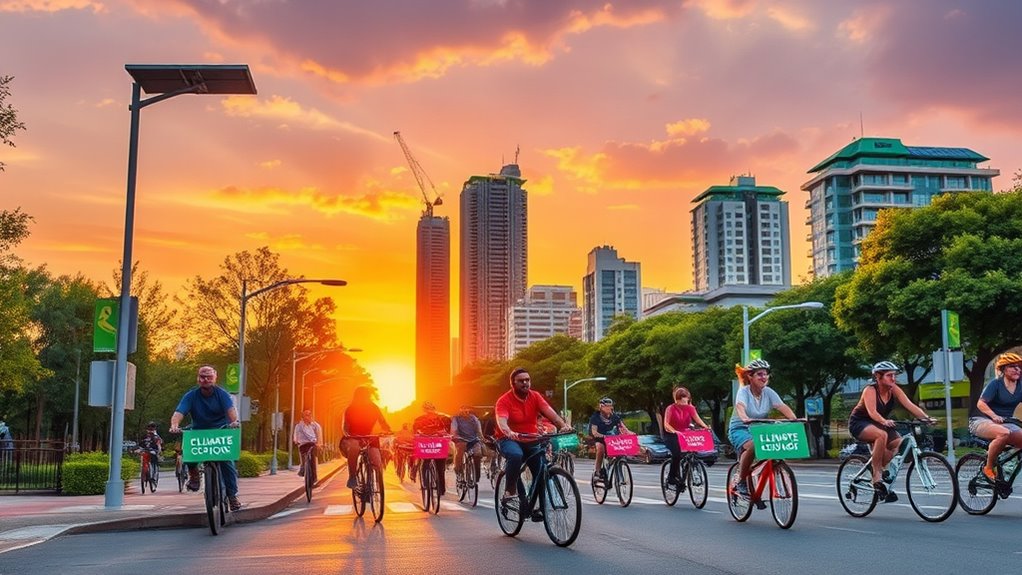Global initiatives are transforming cycling into a crucial tool for climate action and public health. Governments and organizations promote policies supporting cycling infrastructure, eco-friendly materials, and active travel to reduce emissions and improve urban resilience. Projects foster social equity, encourage active lifestyles, and create economic opportunities. Partnerships worldwide enhance these efforts, integrating cycling with sustainable transport systems. To discover how these initiatives make a difference and what’s next, continue exploring the innovative strategies shaping our future.
Key Takeaways
- International organizations like the World Cycling Alliance promote global policies supporting cycling as a climate mitigation strategy.
- The European Declaration on Cycling (2024) emphasizes sustainability, safety, and infrastructure integration across countries.
- Many countries are developing Sustainable Urban Mobility Plans (SUMPs) to expand cycling infrastructure and reduce emissions.
- Global partnerships facilitate knowledge sharing and innovative solutions for cycling infrastructure and climate resilience.
- Promoting cycling aligns with UN climate goals by reducing transport-related CO2 emissions and supporting sustainable urban development.
The Rise of European Policies Supporting Cycling and Active Travel
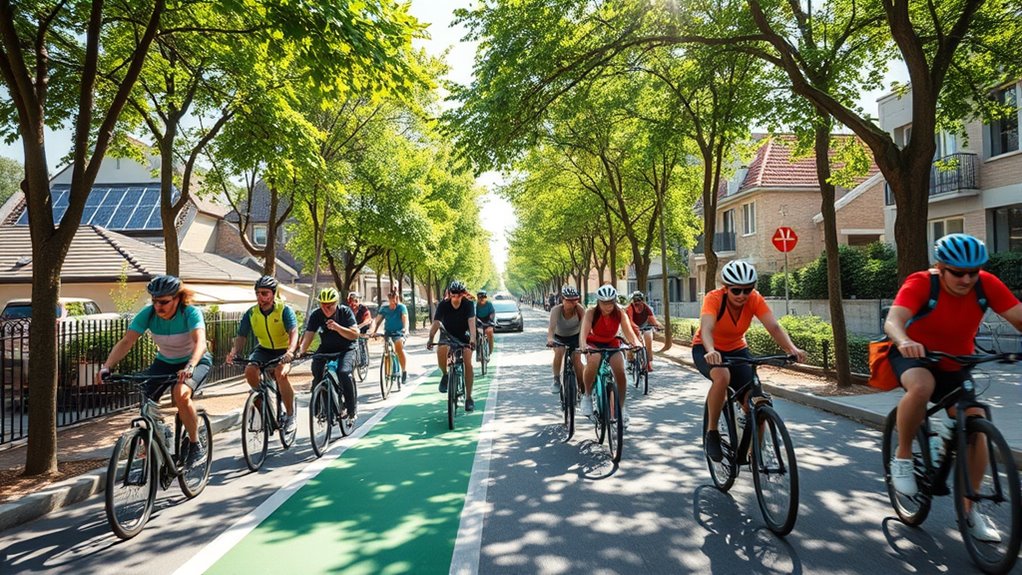
Have European policymakers recognized the importance of cycling and active travel? Absolutely. The European Declaration on Cycling (2024) labels cycling a strategic transport priority, focusing on sustainability, inclusivity, and economic benefits.
Revisions to the TEN-T Regulation require 431 major cities to develop Sustainable Urban Mobility Plans (SUMPs) by 2027, integrating cycling infrastructure. These plans often include urban planning strategies to promote active transportation modes and enhance overall mobility. Incorporating cycling infrastructure into urban planning helps create safer and more efficient environments for cyclists.
New rules also mandate cycling access at multimodal passenger hubs, improving first- and last-mile connectivity. Additionally, cycling infrastructure design options are continually evolving to improve safety and user experience, encouraging more people to choose active travel.
The 2021 Pan-European Master Plan, endorsed by 56 countries, emphasizes cycling safety and infrastructure integration with urban planning.
Countries like Lithuania, Estonia, Denmark, Greece, and Slovenia are developing national cycling strategies, reflecting a broader commitment.
These policies aim to embed cycling into urban transport systems, making active travel safer, more accessible, and aligned with sustainability goals. Innovative design options in cycling infrastructure further enhance user experience and safety.
How Cycling Contributes to Climate Goals and Emissions Reductions
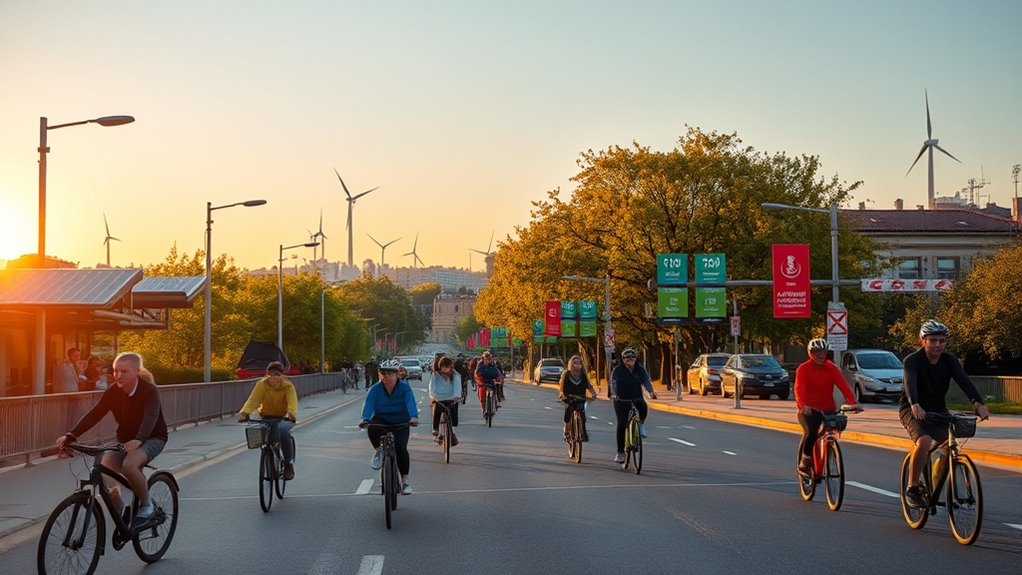
Cycling plays a vital role in reducing greenhouse gas emissions and helping achieve climate goals, offering a sustainable alternative to motorized transport. By choosing to bike instead of driving, you can cut your emissions considerably—cycling emits just 33 grams of CO2 per mile, compared to cars that can produce up to 30 times more.
Switching short trips from cars to bikes can reduce emissions by 75%, and replacing one daily car trip with cycling can save about half a ton of CO2 annually. E-bikes further lower emissions by 67% per trip.
On a larger scale, a 10% shift in the population’s trips to cycling cuts transport emissions by 10%, with EU-wide cycling efforts saving millions of tons of CO2 yearly. Your active choices contribute directly to global climate mitigation.
Advancing Health Benefits Through Active Mobility Initiatives

Engaging in active mobility initiatives offers significant health advantages that extend beyond physical fitness. By choosing cycling or walking, you reduce your risk of noncommunicable diseases like diabetes, heart disease, and certain cancers. These activities help lower obesity rates and decrease healthcare costs by improving overall health.
Regular movement strengthens your cardiovascular system, boosts immune function, and reduces sedentary behavior-related risks. Additionally, active commuting can improve mental health by lowering stress and anxiety through exposure to green spaces. It also enhances mood, sleep quality, and cognitive function. The inclusion of high refresh rates in cycling-related technology, like smart bikes and displays, can further enhance rider experience and safety, especially when integrated with advanced display technology. Understanding power requirements for appliances and devices can also help promote energy-efficient practices among active commuters who use smart devices during their routines. Moreover, incorporating ergonomic design in cycling equipment can reduce fatigue and injury, making active travel safer and more comfortable. Incorporating behavior change strategies can motivate more individuals to adopt active mobility habits sustainably.
Environmental benefits, like reduced air and noise pollution, contribute to better respiratory health and lower stress levels. Overall, active mobility initiatives promote a healthier, more resilient population while supporting sustainable, eco-friendly urban living.
Promoting Social Equity in Cycling Infrastructure and Access

Promoting social equity in cycling infrastructure and access requires intentional planning that centers on fairness and inclusivity. You should focus on equitable resource distribution, prioritizing underserved neighborhoods based on socioeconomic status and transit dependency. Using tools like the Bicycle Equity Index and GIS-based access coverage helps identify disparities, guiding targeted investments. Incorporating data-driven marketing strategies can enhance community outreach and ensure that diverse populations are informed about new cycling initiatives. Addressing systemic exclusion involves overcoming barriers like limited funding and political biases, while leveraging facilitators such as community partnerships and data-driven advocacy. To close racial and economic gaps, infrastructure must be sited near transit hubs and essential services, with programs like subsidized bike-sharing reducing costs. Engaging residents through participatory planning and culturally responsive outreach ensures infrastructure meets local needs, fostering safer, more accessible cycling options for everyone. Additionally, understanding the diverse needs of different communities is essential for creating inclusive cycling environments that promote equity and participation. Incorporating inclusive design principles can further ensure that infrastructure accommodates all users, regardless of ability or background, fostering a more equitable cycling landscape. Recognizing the importance of high-quality materials in infrastructure ensures durability and safety across diverse environments, supporting long-term accessibility and inclusion.
Innovations in Cycling Infrastructure for Climate Resilience
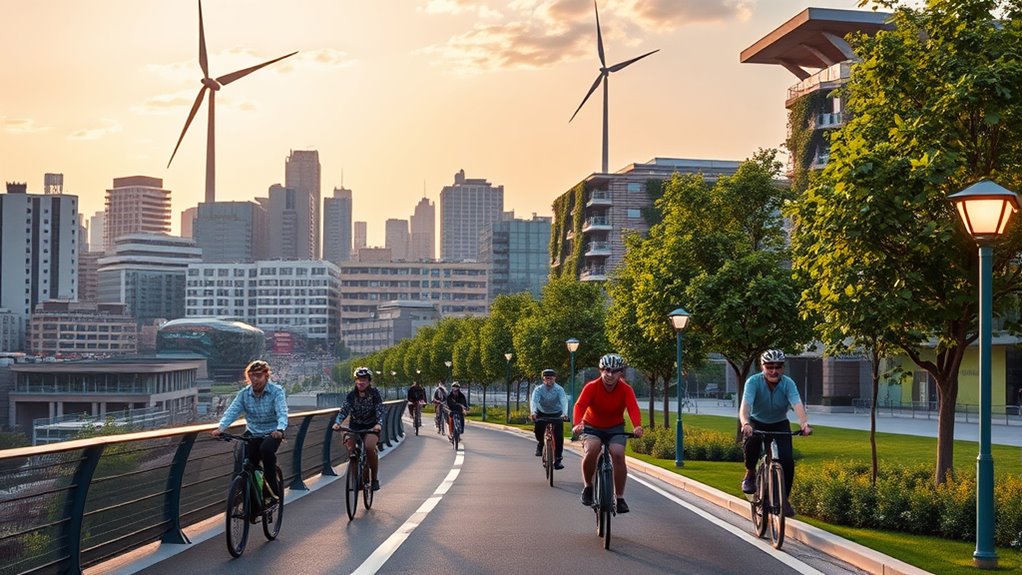
Innovations in cycling infrastructure are crucial for building climate resilience in urban areas. Green infrastructure, like increased greenery in lanes and pedestrian zones, helps lower temperatures and creates more comfortable riding conditions. Shaded paths and tree-lined walkways, such as in Yichang, China, mitigate extreme heat, making cycling safer and more appealing. Incorporating variety of materials in infrastructure design can improve durability and user comfort. Installing drinking fountains along routes boosts rider hydration and comfort. Protected cycling networks, seen in Guangzhou and Bogotá, considerably cut emissions and encourage more people to bike. Linear parks act as natural barriers against heat and pollution, enhancing cycling environments. Smart, heat-safe, and adaptive designs—like flood-resistant pathways and improved signage—support year-round riding. Innovative materials used in infrastructure can also enhance the resilience and longevity of cycling facilities. Additionally, integrating sustainable practices into construction and maintenance ensures these advancements contribute positively to the environment. Incorporating climate-adaptive features into infrastructure planning is essential for addressing the challenges posed by climate change and ensuring continuous, safe cycling options. Using proper maintenance practices can further extend the lifespan of cycling infrastructure and reduce repair costs.
Economic Opportunities and Benefits of Cycling Expansion

Expanding cycling infrastructure offers significant economic benefits for cities and communities. It creates jobs in construction and maintenance while stimulating local economies through increased spending.
Expanding cycling infrastructure boosts local economies and creates jobs in construction and maintenance.
Cycling also spurs new industries, such as tourism and bike services, generating additional revenue. Investing in cycling infrastructure is cost-effective; it costs less to build than vehicle roads and reduces societal expenses related to healthcare and pollution.
Cycling promotes health, cutting healthcare costs, and alleviates traffic congestion, boosting urban efficiency. The bicycle industry itself benefits from increased demand, supporting jobs and economic activity.
Cyclists often shop locally, helping small businesses thrive. Overall, a global shift toward cycling could save society trillions, making it a smart, sustainable investment that benefits communities economically and environmentally.
Building Global Networks and Partnerships for Cycling Advocacy
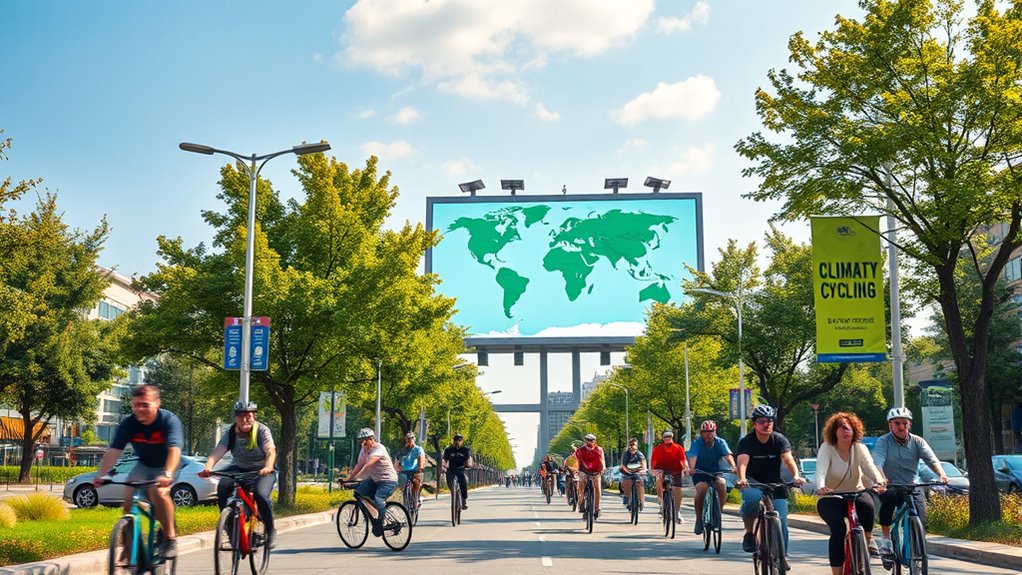
Building strong global networks and partnerships is key to advancing cycling advocacy worldwide. Organizations like the World Cycling Alliance team up with groups such as the European Cyclists’ Federation to boost efforts across borders. These alliances focus on creating bike-friendly environments, promoting sustainable transport, and improving road safety.
International collaborations aim to address climate impact, expand access for underrepresented communities, and share best practices globally. Partnerships often involve secretariat support from organizations like the European Cyclists’ Federation, ensuring operational efficiency. Promoting sustainable transport is essential to reducing carbon emissions and combating climate change.
Effective information sharing among these groups facilitates the dissemination of innovative strategies and successful policies, strengthening the global movement. You can see how these efforts align with commitments to the United Nations climate goals, emphasizing cycling as a crucial climate solution. By fostering international cooperation, these networks enhance advocacy, influence policies, and foster a global movement toward healthier, greener transportation for everyone.
The Future of Cycling in Climate and Public Health Strategies
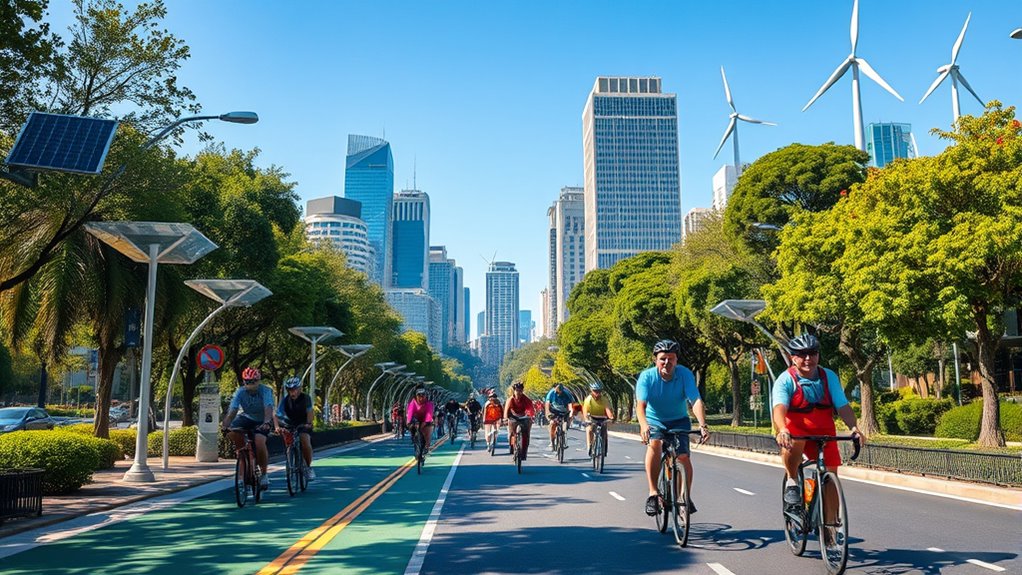
As cycling becomes increasingly integrated into climate and public health strategies, its potential to reduce emissions and improve well-being grows more significant. Converting just 15% of car trips to e-bikes could cut transportation emissions by 12%, and choosing bikes daily can reduce individual carbon footprints by 67%. Additionally, implementing current news in Indonesia can inspire local initiatives to promote cycling as a sustainable transportation option. The EU’s focus on dedicated cycling infrastructure aims to lower reliance on fossil-fuel transit, supporting decarbonization efforts. Additionally, cycling helps combat inactivity, saving lives by reducing chronic diseases and improving mental health.
Advances in e-bike technology, smart systems, and data-driven planning will make cycling safer and more accessible. Expanding infrastructure, fostering public-private partnerships, and integrating cycling with public transit will further embed it into our mobility landscape, making sustainable, healthy transport the norm.
Frequently Asked Questions
How Do Cycling Policies Impact Urban Air Quality Improvements?
You see, cycling policies directly improve urban air quality by encouraging more people to ride bikes instead of driving cars, which lowers emissions.
When cities plan for bike lanes and promote cycling programs, they reduce traffic congestion and pollution.
Combining these policies with public transport makes a bigger difference.
What Are the Main Barriers for Cycling Adoption in Low-Income Communities?
You face several barriers when it comes to cycling in low-income communities. Limited safe infrastructure, such as bike lanes and secure storage, makes riding risky and inconvenient.
Economic hurdles like the high cost of bikes and maintenance also play a role. Social norms and stereotypes discourage cycling as a viable option.
Lack of community support and insufficient government investment further hinder your ability to ride comfortably and safely.
How Can Cycling Infrastructure Adapt to Climate Change Challenges?
You can adapt cycling infrastructure to climate change by designing resilient, green, and protected bike lanes that withstand extreme weather.
Incorporate water access and shade to keep cyclists comfortable during heatwaves.
Use water management systems to prevent flooding and integrate urban greenery to reduce temperatures.
Ensuring accessibility during emergencies and planning for climate stressors helps create a sustainable, inclusive cycling network that supports long-term climate resilience and urban health.
What Role Do Youth Programs Play in Promoting Active Mobility?
You see, youth programs are essential for promoting active mobility by engaging kids in cycling early on. They teach safety, build confidence, and make biking fun, encouraging lifelong habits.
Through school-based and community initiatives, you help foster social connections and physical health. These programs also raise awareness about cycling’s benefits, inspiring a new generation to choose active transportation.
Ultimately, these efforts contribute to creating healthier, more sustainable communities.
How Do International Partnerships Influence National Cycling Initiatives?
You might be surprised how international partnerships shape your country’s cycling efforts. When organizations like the Dutch Cycling Embassy share best practices, they help your government implement smarter bike parking and congestion solutions.
Collaborations like these create a ripple effect, inspiring national policies and funding. By connecting experts worldwide, you benefit from proven strategies that boost cycling infrastructure, safety, and culture, making active mobility more accessible and sustainable for everyone.
Conclusion
By embracing cycling, you’re part of a movement that’s reducing global emissions—did you know that cycling can cut greenhouse gases by up to 21% in urban areas? As policies grow and infrastructure expands, you help create healthier, more equitable cities. Your active choices contribute to a sustainable future, proving that small actions can lead to big change. Keep pedaling forward—your support makes a real difference in tackling climate change.
